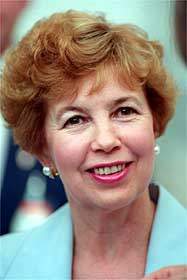
The cause was leukemia, aides to Mr. Gorbachev said. She had been under treatment in University Hospital in Munster since late July.
 |
None of this endeared her to the Soviet public, who began to grumble early in her husband's tenure that she was too pushy, too flashy and too influential. Her appearances on foreign trips and her cultural projects at home stirred debate in many Russian kitchens over whether the proper place for Kremlin wives was -- as it had always been -- at home, or at least in the background.
But since the beginning of this month, when Russians first learned that their former First Lady had been hospitalized in Germany with an advanced and rare case of leukemia, sentiments toward her in Russia began to shift. Favorable articles began to appear in the press, and thousands of letters and telegrams of sympathy arrived at the hospital in Münster, where her husband kept a faithful vigil that touched many Russian hearts.
"It must be in the Russian character -- to run somebody into the mud, and them laud them to high heavens after a tragedy strikes," said Vladimir Polyakov, a Gorbachev spokesman.
President Boris N. Yeltsin, Mr. Gorbachev's bitter rival in the early 1990's, sent a message of condolence today, and in a statement he said that a "wonderful person, a beautiful woman, a loving wife and mother is no longer with us."
In his autobiography, published in 1996, Mr. Gorbachev acknowledged that the resentment over his wife's high profile surfaced in letters written to the Communist Party's Central Committee. "Who does she think she is, a member of the Politburo?" he quoted one as saying. "The simplest answer would have been: 'No, she is my wife.' "
She first became known in the West in 1984 when she accompanied her husband, then a ranking member of the Soviet Politburo, to Britain, where they were received by Prime Minister Margaret Thatcher. Diplomats and reporters, scanning the couple for clues about the next generation of Soviet leaders, quickly focused up on her wardrobe -- in particular her gold lamé sandals with chain straps, a far cry from the dowdy shoes worn by other Kremlin wives. On a later trip to France, the French press labeled her clothes "elegant, but not chic."
On her foreign travels, she also became known for a haughty conversational style that bordered on the pedantic. During the 1986 summit meeting in Reykjavik, Iceland, she needled her tour guides with persistent questioning, adding didactic commentary of her own. Visiting the United States for the first time in 1987, she irked Nancy Reagan with lectures on subjects ranging from architecture to socialism, reportedly prompting the American President's wife to quip, "Who does that dame think she is?"